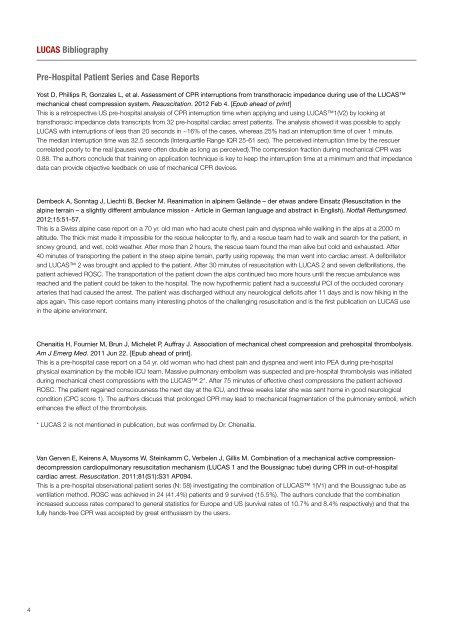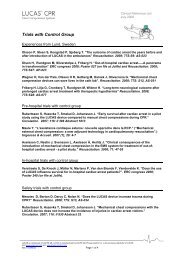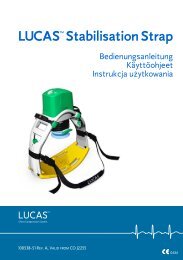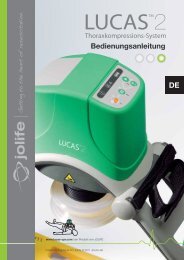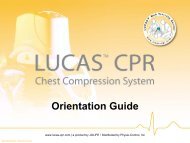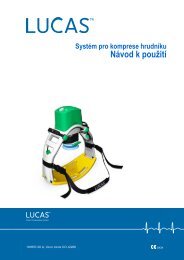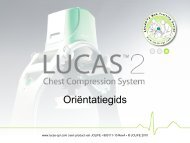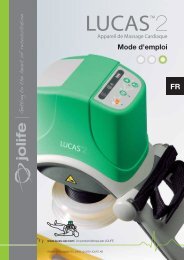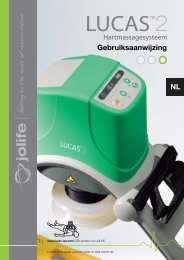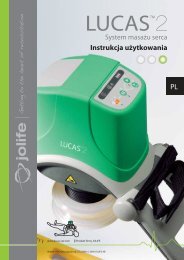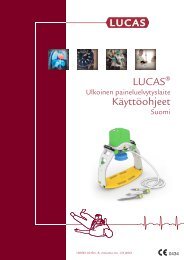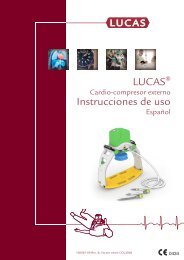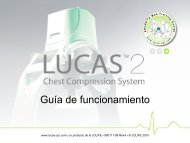LUCAS bib summaries A4 3312304_A_LR.pdf - Jolife
LUCAS bib summaries A4 3312304_A_LR.pdf - Jolife
LUCAS bib summaries A4 3312304_A_LR.pdf - Jolife
Create successful ePaper yourself
Turn your PDF publications into a flip-book with our unique Google optimized e-Paper software.
4<br />
<strong>LUCAS</strong> Bibliography<br />
Pre-Hospital Patient Series and Case Reports<br />
Yost D, Phillips R, Gonzales L, et al. Assessment of CPR interruptions from transthoracic impedance during use of the <strong>LUCAS</strong><br />
mechanical chest compression system. Resuscitation. 2012 Feb 4. [Epub ahead of print]<br />
This is a retrospective US pre-hospital analysis of CPR interruption time when applying and using <strong>LUCAS</strong>1(V2) by looking at<br />
transthoracic impedance data transcripts from 32 pre-hospital cardiac arrest patients. The analysis showed it was possible to apply<br />
<strong>LUCAS</strong> with interruptions of less than 20 seconds in ~16% of the cases, whereas 25% had an interruption time of over 1 minute.<br />
The median interruption time was 32.5 seconds (Interquartile Range IQR 25-61 sec). The perceived interruption time by the rescuer<br />
correlated poorly to the real (pauses were often double as long as perceived).The compression fraction during mechanical CPR was<br />
0.88. The authors conclude that training on application technique is key to keep the interruption time at a minimum and that impedance<br />
data can provide objective feedback on use of mechanical CPR devices.<br />
Dembeck A, Sonntag J, Liechti B, Becker M. Reanimation in alpinem Gelände – der etwas andere Einsatz (Resuscitation in the<br />
alpine terrain – a slightly different ambulance mission - Article in German language and abstract in English). Notfall Rettungsmed.<br />
2012;15:51-57.<br />
This is a Swiss alpine case report on a 70 yr. old man who had acute chest pain and dyspnea while walking in the alps at a 2000 m<br />
altitude. The thick mist made it impossible for the rescue helicopter to fly, and a rescue team had to walk and search for the patient, in<br />
snowy ground, and wet, cold weather. After more than 2 hours, the rescue team found the man alive but cold and exhausted. After<br />
40 minutes of transporting the patient in the steep alpine terrain, partly using ropeway, the man went into cardiac arrest. A defibrillator<br />
and <strong>LUCAS</strong> 2 was brought and applied to the patient. After 30 minutes of resuscitation with <strong>LUCAS</strong> 2 and seven defibrillations, the<br />
patient achieved ROSC. The transportation of the patient down the alps continued two more hours until the rescue ambulance was<br />
reached and the patient could be taken to the hospital. The now hypothermic patient had a successful PCI of the occluded coronary<br />
arteries that had caused the arrest. The patient was discharged without any neurological deficits after 11 days and is now hiking in the<br />
alps again. This case report contains many interesting photos of the challenging resuscitation and is the first publication on <strong>LUCAS</strong> use<br />
in the alpine environment.<br />
Chenaitia H, Fournier M, Brun J, Michelet P, Auffray J. Association of mechanical chest compression and prehospital thrombolysis.<br />
Am J Emerg Med. 2011 Jun 22. [Epub ahead of print].<br />
This is a pre-hospital case report on a 54 yr. old woman who had chest pain and dyspnea and went into PEA during pre-hospital<br />
physical examination by the mobile ICU team. Massive pulmonary embolism was suspected and pre-hospital thrombolysis was initiated<br />
during mechanical chest compressions with the <strong>LUCAS</strong> 2*. After 75 minutes of effective chest compressions the patient achieved<br />
ROSC. The patient regained consciousness the next day at the ICU, and three weeks later she was sent home in good neurological<br />
condition (CPC score 1). The authors discuss that prolonged CPR may lead to mechanical fragmentation of the pulmonary emboli, which<br />
enhances the effect of the thrombolysis.<br />
* <strong>LUCAS</strong> 2 is not mentioned in publication, but was confirmed by Dr. Chenaitia.<br />
Van Gerven E, Keirens A, Muysoms W, Steinkamm C, Verbelen J, Gillis M. Combination of a mechanical active compressiondecompression<br />
cardiopulmonary resuscitation mechanism (<strong>LUCAS</strong> 1 and the Boussignac tube) during CPR in out-of-hospital<br />
cardiac arrest. Resuscitation. 2011;81(S1):S31 AP094.<br />
This is a pre-hospital observational patient series (N: 58) investigating the combination of <strong>LUCAS</strong> 1(V1) and the Boussignac tube as<br />
ventilation method. ROSC was achieved in 24 (41.4%) patients and 9 survived (15.5%). The authors conclude that the combination<br />
increased success rates compared to general statistics for Europe and US (survival rates of 10.7% and 8.4% respectively) and that the<br />
fully hands-free CPR was accepted by great enthusiasm by the users.


